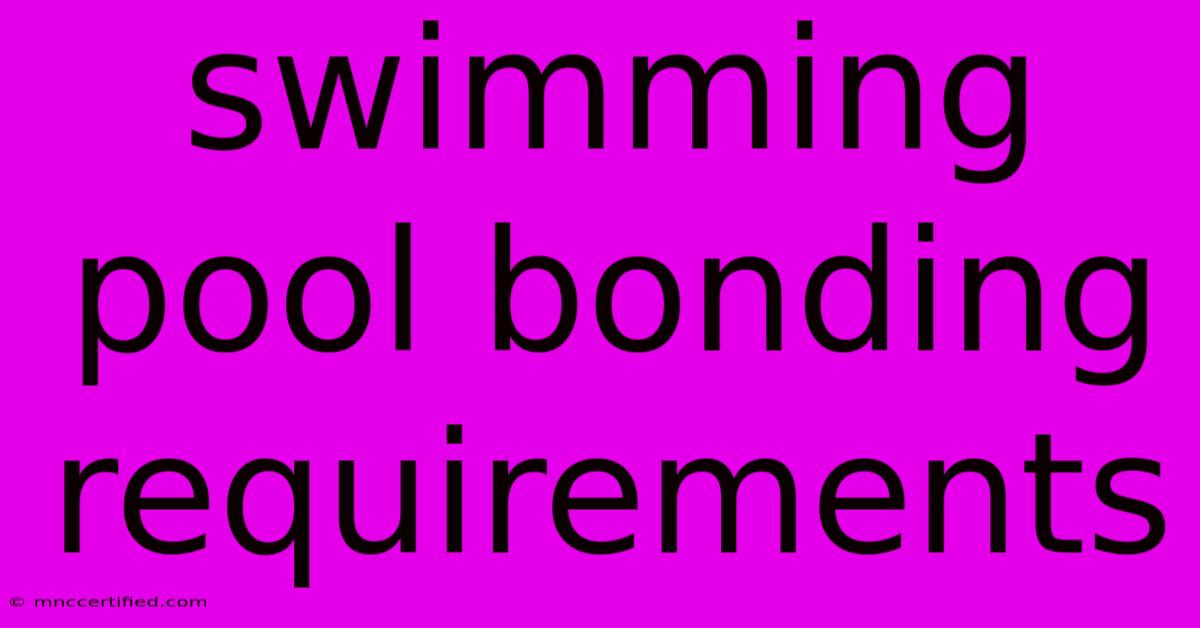Swimming Pool Bonding Requirements

Table of Contents
Swimming Pool Bonding Requirements: Ensuring Safety and Compliance
Owning a swimming pool is a dream for many, offering a refreshing escape and a place for fun and relaxation. But with the enjoyment comes responsibility, and one crucial aspect is electrical safety. This is where swimming pool bonding comes in, playing a vital role in preventing electrical shocks and ensuring the well-being of everyone using the pool.
Understanding Pool Bonding
Pool bonding is a safety measure that connects all metallic parts within the pool environment to a common grounding point. This ensures that if a stray electrical current enters the water, it will be safely directed to the ground instead of traveling through the water and potentially causing harm.
Here are some key elements that must be bonded:
- Pool Shell: The metal or fiberglass shell of the pool itself.
- Ladders, Rails, and Handrails: Any metal components that are submerged in the water or near the pool's edge.
- Lights and Fixtures: Including underwater lights, surface lights, and any other electrical components near the pool.
- Filters, Pumps, and Equipment: All metal parts of the pool's filtration and circulation system.
- Metal Fencing: If the pool area has a metal fence.
Why Pool Bonding is Essential
Electrical accidents near swimming pools are a serious concern. Even a small electrical fault can be fatal if it comes into contact with water. Pool bonding serves as a critical safety net to:
- Prevent Electrical Shocks: By providing a low-resistance path for current to flow to the ground, bonding reduces the risk of electrical shock.
- Eliminate Stray Currents: Stray currents, often caused by faulty wiring or corrosion, can be dangerous. Bonding effectively eliminates these currents, preventing potential hazards.
- Meet Local Building Codes: Bonding requirements are typically mandated by local building codes, ensuring a minimum level of safety for all swimming pools.
Compliance and Installation
Bonding requirements can vary depending on your location, so it's crucial to check your local building codes and regulations.
Here are some general guidelines:
- Professional Installation: Always hire a qualified electrician experienced with swimming pool bonding to ensure the work is done correctly and meets all local codes.
- Copper Bonding Wire: Typically, copper bonding wire with a minimum size of #6 AWG is used for bonding connections.
- Bonding Lugs: These are specialized terminals used to create secure connections between the bonding wire and metallic parts.
- Grounding Rod: A grounding rod is typically driven into the ground and connected to the bonding system, providing a low-resistance path for current to flow to the earth.
- Inspection: After installation, it's essential to have the bonding system inspected and tested by a qualified electrician to verify its functionality and compliance.
Maintaining Safety
While proper installation is critical, ongoing maintenance is equally important to ensure your bonding system continues to work effectively:
- Regular Inspections: Periodically inspect all bonding connections for any signs of corrosion or damage.
- Corrosion Protection: Protect bonding wire and connections from corrosion with appropriate coatings or by using corrosion-resistant materials.
- Prompt Repair: If any damage or issues are found, have them addressed promptly by a qualified electrician.
The Bottom Line: Safety First
Pool bonding is an essential safety measure that should never be overlooked. By investing in a properly installed and maintained bonding system, you can protect yourself and your loved ones from the dangers of electrical hazards in your swimming pool environment. Remember, when it comes to swimming pool safety, compliance and vigilance are key.

Thank you for visiting our website wich cover about Swimming Pool Bonding Requirements. We hope the information provided has been useful to you. Feel free to contact us if you have any questions or need further assistance. See you next time and dont miss to bookmark.
Featured Posts
-
Spend Connect Live Key Innovations
Nov 15, 2024
-
Onion Wins Bid For Alex Jones Firm
Nov 15, 2024
-
Craig Melvin Replaces Hoda Kotb On Today
Nov 15, 2024
-
Sleep Study Cost Without Insurance
Nov 15, 2024
-
Eva Longoria Relocates Amid Trump Criticism
Nov 15, 2024